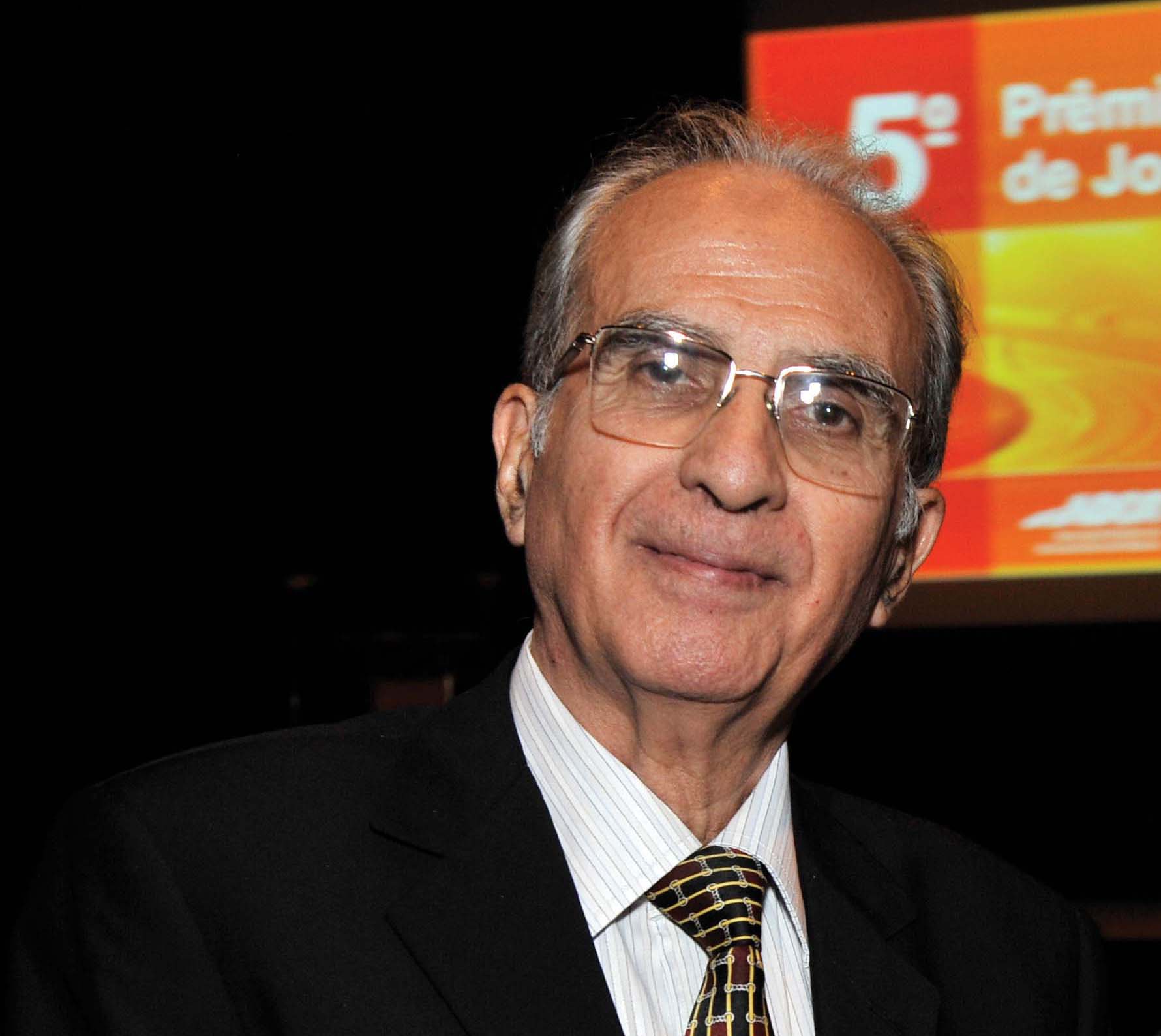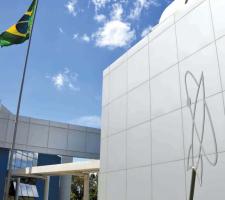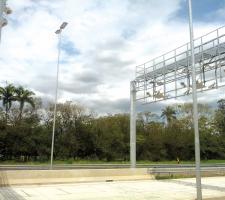
Gil Guedes, technical director of the Brazilian association of motorway concessionaires (ABCR)
David Crawford explores the technical background of Brazil’s First multi-lane free-flow tolling system.
The 2013 opening of Brazil’s first fully-operational, all-vehicle, multi-lane free-flow (MLFF) tolling system in the state of São Paolo has set the scene for a new phase of modern electronic fee collection (EFC) deployment in Latin America’s largest country. It has toll programmes at both federal and state levels, with São Paulo – the most populous state, with the largest road network – leading in the awarding of concessionary contracts to private companies.
Implemented under the auspices of the state government by Renovias (which manages 346km of state roads), the new system deploys French energy management company Schneider Electric’s SmartMobility free-flow tolling technology on the SP340 motorway (Rodovia Governador Adhemar Pereira de Barros). This serves more than 2.25 million residents of the Campinas metropolitan region; a major centre of industry and high-tech innovation to the north of the state capital of São Paulo city.
The system delivers vehicle detection with the ability to read tags using both 5.8GHz and 915MHz frequencies, as well as the camera-based capture of both front and rear licence plates using optical character recognition (OCR) technology. It went live following two earlier, limited, car-only pilots; and successfully completing a full-scale testing phase that achieved reading accuracy levels of more than 99.97%.
The volume of automated transactions is currently running at around one million a month. This is expected to rise sharply as more drivers become familiar with the new system and its convenience.
Schneider Electric claims the implementation of its technology for Renovias to be the First fully-operational scheme in the world to integrate both 915MHz and 5.8GHz tag readers in the same gantry – a specific technical requirement of the project. The dual system allows Renovias to accommodate users of:
Front and rear licence plate reading is standard for Schneider Electric MLFF projects, allowing the capture of motorcycles and trailers, as well as of cars and trucks.
Carmona told ITS International: “We have designed the system to be scalable, to change over time and allow the integration of new infrastructure or segments.”
The technology is fully compatible with São Paulo’s Artefato 915MHz protocol, one of two currently applying in Brazil (see below). The country is now progressively migrating its installed tag base to 915MHz - a return to the frequency that was originally adopted some 15 years ago, prior to a change following the arrival of a European supplier.
Gil Guedes, technical coordinator of Associação Brasileira de Concessionárias de Rodovias (ABCR), the Brazilian association of motorway concessionaires, told ITS International “we are entirely in favour of MLFF.
Once all vehicles have a tag installed, a larger number of road users will pay tolls, allowing for reductions in tariffs while keeping concessionaires’ income intact.
“Before this can happen, however, there needs to be effective regulation of vehicle classifications and Toll evasions. In Brazil, only police authorities are legally empowered to enforce traffic and Toll violations.”
Brazil’s Departamento Nacional de Trânsito (Denatran) has established the 915MHz-based National System for Automatic Vehicle Identification known as Sistema Nacional de Identificação Automática de Veículos (SINIAV) as the new national protocol. The aim is to enable the mandatory electronic registration of all road vehicles by using a single passive chip.
The main drivers of the initiative are the pressing needs for:
Brazilian R&D contractor Von Braun Laboratories (VBL) developed the key technical specifications for the tags and the tag reading system covering both frequencies. February 2014 saw the soft start of implementation in Roraima, the country’s least populated state. The government’s official timetable envisages the entire national vehicle fleet being equipped with tags by July 2015.
São Paulo state made an early decision to adopt Siniav for its new automated tolling system. At that time, however, the federal government was not in a position to integrate state-level operations into its back office.
The state’s Agência Reguladora de Serviços Públicos de Transporte de São Paulo (ARTESP), the regulatory agency for public transport services, therefore engaged Von Braun in 2011 to specify, develop, implement and operate its local Artefato version. Von Braun director Dario Sassi Thober told ITS International: “We created a version similar to Siniav, aiming for future integration with the national system.”
In February 2014, Brazil’s Agencia Nacional de Trasportes Terrestres (ANTT) – the national regulatory authority for land transport – announced that Artefato is going national, alongside Siniav. It had already, in 2013, launched a public consultation on the harmonisation of the two specifications.
Says Guedes: “There is as yet no defined timetable, but conversations keep going. In case we don’t achieve harmonisation, multiprotocol readers are already being considered.”
A second system developed for the government - Brasil-ID – using similar identification specifications and infrastructures for cargo and product management and security is now deployed in 14 Brazilian states. The technology is close enough to allow potential interoperability with the tolling systems.
Meanwhile, Von Braun is working on a second generation of components and systems designed to reduce costs and speed up growth of the country’s installed base. Says Thober: “We have reached a price of US$100,000 for a fully functional, three-lane, MLFF vehicle identification and classification system, with a unit price of around US$1 for the onboard tag. We are testing this on some 10,000 vehicles during 2014.”
Despite Brazil sharing boundaries with every other South American country except Chile, all the technical activity is taking place within a purely national framework.
Cross-border interoperability, says Guedes, “is, to the best of my knowledge, a topic absent from all international agreements in South America so far.”
These developments are also occurring against the background of a fundamental legal challenge to the constitutional status of the industry as a whole. According to Canada-based Brazilian lawyer Fábio Chagas Theophilo, “most of Brazil’s toll-highway system is illegal”, (see <%$Linker:2 External <?xml version="1.0" encoding="utf-16"?><dictionary /> 0 0 0 oLinkExternal http://ir.lib.uwo.ca/cgi/viewcontent.cgi?article=2577&context=etd Visit ir.lib.uwo.ca false http://ir.lib.uwo.ca/cgi/viewcontent.cgi?article=2577&context=etd false false %>). This is despite the fact that the country’s laws permit the use of toll-highways ‘for the raising of public revenue’.
Theophilo cites the government’s ‘lawfulness principle’, under which all government acts must be authorised by law. He alleges failures in both the authorisation of concessions (the relevant laws are “impermissibly vague”) and the regulation of toll operations (the current system is “unconstitutionally vague”). The government should, he says, be guided by the example of the regulation of the country’s telecommunications sector.
In response, ARTESP states that there are no illegal aspects of the tolling system and road concession contracts used in São Paulo. All its concessions are based on, and obey, the federal and state laws that rule the sector. Before publication ITS International had asked ANTT to comment on the lawyer’s statement but it failed to respond.
Tolling in Brazil
Brazil has 55 private concessionaires operating nearly 300 toll plazas in 10 southern and eastern states, mostly emerging since 1999. They account for over half the country’s 10,300km of multilane highway and have generated revenues of US$31bn over a 16-year period. São Paulo state has initiated and developed 4,517 km of multilane highway with 83% of the system operating under concessions and generating more than US$3.8bn a year in revenue.
Von Braun Laboratories is a not-for-profit technical research organisation. Founded in 1997, it became an accredited centre of the Brazilian Science and Technology Ministry (MCTI) in 2002.
It represents Brazil on technical committees of the International Standards Organisation (ISO) and GS1, the global business information exchange standards body (and original developer of the barcode). It has presented both bodies with its fully-passive 915MHz chip using the US-established Advanced Encryption Standard (AES) 128 for data security.
The 2013 opening of Brazil’s first fully-operational, all-vehicle, multi-lane free-flow (MLFF) tolling system in the state of São Paolo has set the scene for a new phase of modern electronic fee collection (EFC) deployment in Latin America’s largest country. It has toll programmes at both federal and state levels, with São Paulo – the most populous state, with the largest road network – leading in the awarding of concessionary contracts to private companies.
Implemented under the auspices of the state government by Renovias (which manages 346km of state roads), the new system deploys French energy management company Schneider Electric’s SmartMobility free-flow tolling technology on the SP340 motorway (Rodovia Governador Adhemar Pereira de Barros). This serves more than 2.25 million residents of the Campinas metropolitan region; a major centre of industry and high-tech innovation to the north of the state capital of São Paulo city.
The system delivers vehicle detection with the ability to read tags using both 5.8GHz and 915MHz frequencies, as well as the camera-based capture of both front and rear licence plates using optical character recognition (OCR) technology. It went live following two earlier, limited, car-only pilots; and successfully completing a full-scale testing phase that achieved reading accuracy levels of more than 99.97%.
The volume of automated transactions is currently running at around one million a month. This is expected to rise sharply as more drivers become familiar with the new system and its convenience.
Schneider Electric claims the implementation of its technology for Renovias to be the First fully-operational scheme in the world to integrate both 915MHz and 5.8GHz tag readers in the same gantry – a specific technical requirement of the project. The dual system allows Renovias to accommodate users of:
- The 5.8GHz tags that are widely used in Europe – and, at present, by the majority of drivers in Brazil as a whole (with 4.2 million tags in circulation); and
- The 915MHz alternative, widely used in the US and, now, the new standard for São Paulo state, which is increasingly being adopted elsewhere.
Front and rear licence plate reading is standard for Schneider Electric MLFF projects, allowing the capture of motorcycles and trailers, as well as of cars and trucks.
Carmona told ITS International: “We have designed the system to be scalable, to change over time and allow the integration of new infrastructure or segments.”
The technology is fully compatible with São Paulo’s Artefato 915MHz protocol, one of two currently applying in Brazil (see below). The country is now progressively migrating its installed tag base to 915MHz - a return to the frequency that was originally adopted some 15 years ago, prior to a change following the arrival of a European supplier.
Gil Guedes, technical coordinator of Associação Brasileira de Concessionárias de Rodovias (ABCR), the Brazilian association of motorway concessionaires, told ITS International “we are entirely in favour of MLFF.
Once all vehicles have a tag installed, a larger number of road users will pay tolls, allowing for reductions in tariffs while keeping concessionaires’ income intact.
“Before this can happen, however, there needs to be effective regulation of vehicle classifications and Toll evasions. In Brazil, only police authorities are legally empowered to enforce traffic and Toll violations.”
915MHz protocols
Brazil’s Departamento Nacional de Trânsito (Denatran) has established the 915MHz-based National System for Automatic Vehicle Identification known as Sistema Nacional de Identificação Automática de Veículos (SINIAV) as the new national protocol. The aim is to enable the mandatory electronic registration of all road vehicles by using a single passive chip.
The main drivers of the initiative are the pressing needs for:
- An effective method of identification to support accurate vehicle registration and regulation in a country with high levels of unregistered vehicles and car thefts; and
- A multi-purpose tool for ground transport management, with 70% of the country’s goods being transported by trucks, cargo security is a major concern.
Brazilian R&D contractor Von Braun Laboratories (VBL) developed the key technical specifications for the tags and the tag reading system covering both frequencies. February 2014 saw the soft start of implementation in Roraima, the country’s least populated state. The government’s official timetable envisages the entire national vehicle fleet being equipped with tags by July 2015.
São Paulo state made an early decision to adopt Siniav for its new automated tolling system. At that time, however, the federal government was not in a position to integrate state-level operations into its back office.
The state’s Agência Reguladora de Serviços Públicos de Transporte de São Paulo (ARTESP), the regulatory agency for public transport services, therefore engaged Von Braun in 2011 to specify, develop, implement and operate its local Artefato version. Von Braun director Dario Sassi Thober told ITS International: “We created a version similar to Siniav, aiming for future integration with the national system.”
In February 2014, Brazil’s Agencia Nacional de Trasportes Terrestres (ANTT) – the national regulatory authority for land transport – announced that Artefato is going national, alongside Siniav. It had already, in 2013, launched a public consultation on the harmonisation of the two specifications.
Says Guedes: “There is as yet no defined timetable, but conversations keep going. In case we don’t achieve harmonisation, multiprotocol readers are already being considered.”
A second system developed for the government - Brasil-ID – using similar identification specifications and infrastructures for cargo and product management and security is now deployed in 14 Brazilian states. The technology is close enough to allow potential interoperability with the tolling systems.
Meanwhile, Von Braun is working on a second generation of components and systems designed to reduce costs and speed up growth of the country’s installed base. Says Thober: “We have reached a price of US$100,000 for a fully functional, three-lane, MLFF vehicle identification and classification system, with a unit price of around US$1 for the onboard tag. We are testing this on some 10,000 vehicles during 2014.”
Despite Brazil sharing boundaries with every other South American country except Chile, all the technical activity is taking place within a purely national framework.
Cross-border interoperability, says Guedes, “is, to the best of my knowledge, a topic absent from all international agreements in South America so far.”
These developments are also occurring against the background of a fundamental legal challenge to the constitutional status of the industry as a whole. According to Canada-based Brazilian lawyer Fábio Chagas Theophilo, “most of Brazil’s toll-highway system is illegal”, (see <%$Linker:
Theophilo cites the government’s ‘lawfulness principle’, under which all government acts must be authorised by law. He alleges failures in both the authorisation of concessions (the relevant laws are “impermissibly vague”) and the regulation of toll operations (the current system is “unconstitutionally vague”). The government should, he says, be guided by the example of the regulation of the country’s telecommunications sector.
In response, ARTESP states that there are no illegal aspects of the tolling system and road concession contracts used in São Paulo. All its concessions are based on, and obey, the federal and state laws that rule the sector. Before publication ITS International had asked ANTT to comment on the lawyer’s statement but it failed to respond.
Tolling in Brazil
Brazil has 55 private concessionaires operating nearly 300 toll plazas in 10 southern and eastern states, mostly emerging since 1999. They account for over half the country’s 10,300km of multilane highway and have generated revenues of US$31bn over a 16-year period. São Paulo state has initiated and developed 4,517 km of multilane highway with 83% of the system operating under concessions and generating more than US$3.8bn a year in revenue.
Von Braun Laboratories is a not-for-profit technical research organisation. Founded in 1997, it became an accredited centre of the Brazilian Science and Technology Ministry (MCTI) in 2002.
It represents Brazil on technical committees of the International Standards Organisation (ISO) and GS1, the global business information exchange standards body (and original developer of the barcode). It has presented both bodies with its fully-passive 915MHz chip using the US-established Advanced Encryption Standard (AES) 128 for data security.














